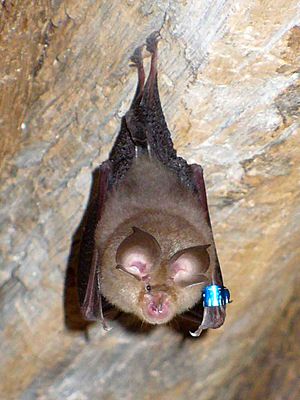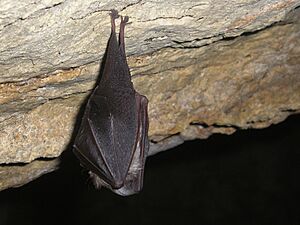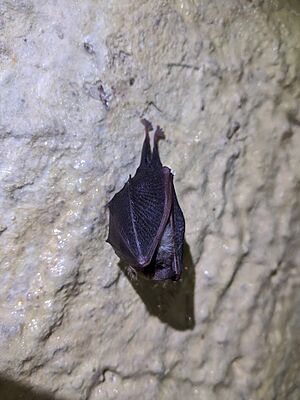Lesser horseshoe bat facts for kids
Quick facts for kids Lesser horseshoe bat |
|
|---|---|
 |
|
| In France | |
| Conservation status | |
| Scientific classification | |
| Genus: |
Rhinolophus
|
| Species: |
hipposideros
|
 |
|
| Lesser horseshoe bat range | |
The lesser horseshoe bat (Rhinolophus hipposideros) is a small bat found in Europe and North Africa. It's an insect-eating animal, related to its bigger cousin, the greater horseshoe bat. Like all horseshoe bats, it gets its name from its special horseshoe-shaped noseleaf on its face.
Contents
What Does It Look Like?
The lesser horseshoe bat is one of the smallest bats in the world. It weighs only about 5 to 9 grams, which is less than a small candy bar! Its wingspan is about 19 to 25 centimeters, and its body is about 3.5 to 4.5 centimeters long.
These bats have strong feet to hold onto rocks and branches. Even though their eyes are small, they can see quite well. Like most bats, they live together in groups. They find their food using echolocation, which is like a natural sonar system. They send out high-pitched sounds from their mouths to find insects.
Their fur is soft and fluffy. The base of their fur is light grey. The fur on their back is smoky brown, and their belly fur is grey. Young bats are completely dark grey. Their ears and wing membranes are a light greyish-brown color.
When they hunt, they are very fast and agile. They often fly low, within five meters of the ground, carefully avoiding bushes. Lesser horseshoe bats eat small insects. They often pick them up from stones and branches. Their favorite foods include flies, mosquitoes, butterflies, moths, and spiders. On average, a lesser horseshoe bat lives for about 3 years. However, some have been known to live much longer!
Life Cycle
Lesser horseshoe bats usually mate in the autumn. Female bats give birth to one baby, called a pup. This usually happens between mid-June and early July.
Newborn pups weigh around 1.8 grams. They open their eyes after about 10 days. They become independent and can fly on their own when they are six to seven weeks old. During the winter, these bats hibernate. They sleep in dark caves, old mines, old buildings, and sometimes in cellars.
Female bats can have babies when they are just one year old. Sometimes, you might see bats chasing each other before they mate.
Female bats gather in special groups called maternity colonies. These are like nurseries where they raise their young. They often share these places with other bat species, like the greater mouse-eared bat. However, they don't mix directly with the other species. Bats start moving to these maternity colonies from April onwards. The size of these groups can be very different, from just a few bats to hundreds! About two-thirds of the females in a nursery group give birth between mid-June and mid-July.
Where Do They Live?
The lesser horseshoe bat prefers warmer areas. They like foothills and highlands, especially wooded places or areas with lots of limestone. They often rest in caves. In summer, they have been found living up to 1,160 meters above sea level. In winter, they can be found up to 2,000 meters high. The highest known nursery for baby bats was found at 950 meters.
These bats don't travel very far. On average, they move about 5 to 10 kilometers between their summer and winter homes. The longest distance ever recorded for one of these bats was 153 kilometers.
Where Can You Find Them?
You can find lesser horseshoe bats in western Ireland and southwest Britain. There are also larger groups in parts of Germany and the Bavarian foothills of the Alps. These bats are common in the Mediterranean area. They live in North Africa and on most of the larger islands, stretching to Asia Minor and around the Black Sea. In Asia, they are found in Kashmir, the Near East, Iran, Iraq, and the Arabian Peninsula. They also live in parts of East Africa.
In the United Kingdom
In the UK, lesser horseshoe bats are mostly found in Wales and the Southwest of England. You can see a map of where they live on the National Biodiversity Network website here.
A large group of breeding lesser horseshoe bats lives in the smallest Site of Special Scientific Interest (SSSI) in the UK. This SSSI is a tiny 7 square meter barn in Gloucestershire, England.
These bats face some threats. Their roosts (where they rest) can be disturbed or destroyed. Changes in agricultural farming practices, like using more insecticides, mean there are fewer insects for them to eat. They also lose suitable places to find food, called habitats.
However, good news! Surveys by the Bat Conservation Trust show that their numbers in the UK are growing. Between 1999 and 2012, their numbers increased by about 4.5% each year. That's a total increase of 77.2% during that time!
In Ireland
Lesser horseshoe bats have been seen in several counties in Ireland. These include Galway, South Mayo, Clare, Limerick, Cork, and Kerry. It's estimated that there are about 13,000 of them in Ireland.
In Israel
The lesser horseshoe bat is quite rare in Israel.
In the Balearic Islands
In the Balearic Islands, Rhinolophus hipposideros lives on all three main islands: Mallorca, Menorca, and Ibiza. They are also found on smaller islands like Cabrera and Formentera. Groups of up to 50 bats have been found in caves, like the Cova de Ca Na Rea in Ibiza. However, most groups are smaller. In the Balearics, these bats usually travel only short distances, about 2 kilometers. They are also the most common bat species on Ibiza.
In Tunisia
In Tunisia, the lesser horseshoe bat is rarer than other bat species. It lives in the northern, humid part of the country. Before 2011, only single bats or small groups of hibernating bats were reported. Then, a maternity colony was found in an abandoned hotel south of Ain Draham. This was the first known maternity colony in Tunisia! The bats were roosting under the roof and in different rooms, not in trees or mines. This discovery suggests that we should look for maternity colonies in abandoned buildings, not just in wooded areas or underground.
Bat Superpower: Echolocation!
Lesser horseshoe bats use very high-pitched sounds for echolocation. The sounds they make are between 93 and 111 kilohertz (kHz). The strongest part of their call is usually at 110 kHz. Each sound lasts for about 31.7 milliseconds. Because of these frequencies, their echolocation calls can sometimes sound similar to those of the Mediterranean horseshoe bat and Mehely's horseshoe bat.
Protecting These Bats
This bat species is protected in the European Union under the Habitats Directive. This means countries must work to protect them and their homes. It is also listed in the Berne Convention, which aims to protect European wildlife. The UNEP-EUROBATS convention also specifically focuses on protecting this species. Many countries and regions also have their own laws to protect these bats and their habitats.
To show how important it is to protect this species across Europe, the lesser horseshoe bat was chosen as the "Bat Species of the Year" for 2018–2019 by BatLife Europe, a large European organization.





